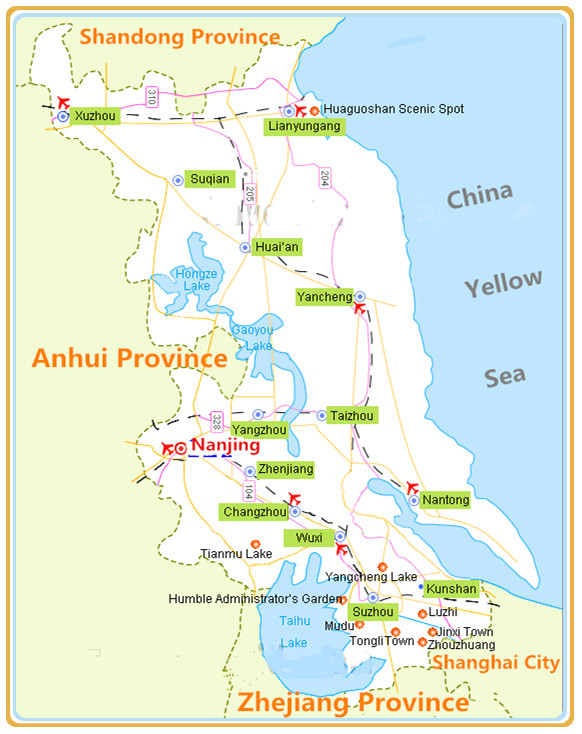Skype: neodalle-travel
Tel: +86 135 7447 2266
E-mail: sales@visitaroundchina.com
 Nanjing is one of the last cities on the Yangtze River and capital of the Jiangsu province. Its population is a large 5.2 million and counting and acts as the capital of southern China. The city today is a multiple force on the economy, producing many industrial goods used throughout the country and for exportation to the world. It is also a vital transportation hub and communication center, not to mention one of the 4 major scientific research and educational cities in China. Nanjing continues to grow economically in double digit percentages every year, leaving its mark on the nation in many ways. Still, Nanjing is a city of much cultural heritage to explore and learn even if it is a modern hub these days. It was one of the 4 ancient capitals of China during the Six Dynasties and Wu Kingdom period into the Ming Dynasty (though it changed names and shapes in the meantime), a and capital of the nation before the Chinese Civil War with Taiwan.
Nanjing is one of the last cities on the Yangtze River and capital of the Jiangsu province. Its population is a large 5.2 million and counting and acts as the capital of southern China. The city today is a multiple force on the economy, producing many industrial goods used throughout the country and for exportation to the world. It is also a vital transportation hub and communication center, not to mention one of the 4 major scientific research and educational cities in China. Nanjing continues to grow economically in double digit percentages every year, leaving its mark on the nation in many ways. Still, Nanjing is a city of much cultural heritage to explore and learn even if it is a modern hub these days. It was one of the 4 ancient capitals of China during the Six Dynasties and Wu Kingdom period into the Ming Dynasty (though it changed names and shapes in the meantime), a and capital of the nation before the Chinese Civil War with Taiwan.How to get to Nanjing?
Nanjing is very accessible and it can be easily reached by flight, train, bus and boat. Transport in the city is very convenient with the new metro service in addition to taxis, public buses, tourist special lines and other means of transport. Nanjing is a comprehensive national communication hub. Its external traffic extends in all directions, including airline, railway and highway, etc. Its internal traffic has developed into a system, consisting of metro, city bus, taxi and ferry, etc. However, the internal traffic does not seem to satisfy the citizens’ demands and traffic jams happen now and then, especially during rush hours and in busy areas. The government has speeded up the construction of traffic infrastructures to solve the problem.
When to visit Nanjing?
The city of Nanjing enjoys 4 seasons including a monsoon period every year. Nanjing is frost-free about 237 days out of the year and has an average annual temperature of 16 degrees Celsius. Summers are very hot and humid while winters are cold and damp. Temperatures in the summer remain high without much reprieve.
Talking about best traveling time, March to May is the greatest period. The weather is most comfortable, not too hot or cold. All kinds of flowers are in full blossom waiting for you to enjoy. September to November is also wonderful, when you can admire the beauty of maple trees.
Nanjing Travel Tips
Since Jan. 30, 2016, the 144-Hour Visa-Free Policy has been implemented in the city to facilitate passport holders of 53 countries and regions to enjoy a visa-free stay up to 144 hours when taking an international transfer via Lukou Airport, and passengers can travel to Shanghai and Zhejiang as well.
Shopping in Nanjing: Xinjiekou is the main shopping district in the city center similar to those found in Tokyo or New York City. You can find most of the top local, regional, national, and international brands here. Hunan Road is like Xinjiekou but on a smaller scale. Finally, be sure to do some shopping around the Confucius Temple market where you can find delightful clothing and artisanal items. Aqua City Shopping Center near Confucius Temple has many western brands and goods available.
Dining in Nanjing: Nanjing food is a smooth combination of regional and local flavors. Traditional Nanjing style is called Jiangsu cuisine based off the name of the province and is distinguished by its original flavor and fresh, raw ingredients. You will find your plates are often well orchestrated in terms of colors and presentation with only minimal seasoning and oil. This yields flavors that are mellow and subtle, suiting all palates. Some of the best places to try typical Jiangsu food are around Qinghua River and Hunan Road. There are countless street stalls that offer local favorites such as baozi (steamed buns stuffed with pork), bawei dawei doufunao (eight-flavored jellied bean curd pastries), roast beef, salty duck, animal stomach, chicken feet (also known as phoenix feet), xiaolongbao (delicate dumplings filled with soup and meat), tangbao (similar dumplings with crab meat and soup), and much more.
Accommodation in Nanjing: This large cite has properties that range from simple guesthouses to full service hotels and resorts. Most of the top rated hotels are in the Xinjiekou district, Nanjing’s commercial area. Budget options include Jasmine International Youth Hostel and Nanjing Danfeng International Hotel. For middle level accommodations, we recommend International Conference Hotel Nanjing, Nanjing Vogue Motel, and Nanjing's Yi Lai Celebrity City Hotel. Luxury options include Regalia Resort & Spa, Tangshan; Grand Metropark Hotel Nanjing, Sheraton Nanjing Kingsley Towers, and Kayumanis Nanjing Private Villa & Spa.
 Ask Questions ?
Ask Questions ?